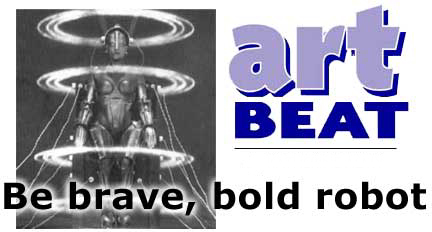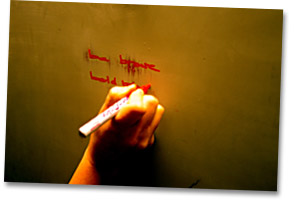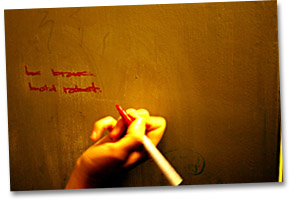|
COVER STORY | IN
THE NEWS | STAGE
MATTERS | OFF
THE PAVEMENT October 12, 2006by CAITLIN COLLINS If you ask people
if they are familiar with the words be brave bold robot,
chances are most women who've spent any time at HSU will recognize
the phrase. Finding the idiom scrolled on bathroom stalls across
campus has always been part of my school experience. It's written
in the girls' bathrooms in all the buildings: written, scrubbed
off, written again, painted over, rewritten and responded to
with other words or drawings. Who's been so devoted to this phrase
and why? What does it mean a B adopted the phrase be brave bold robot from an acquaintance who was putting it up all over Oakland, and decided to bring it north approximately five years ago. She's not sure where the phrase originated -- friends have told her that both Aldous Huxley and Ray Bradbury have thrown the words around. The many possibilities of meanings are part of the fun of sharing the phrase, but for B it has always had a concrete message. be brave bold robot is about the desire to understand what's going on in the human world despite its apparent problems and absurdities. It is about fear and confusion and not always knowing what is right or wrong, yet still always struggling to obtain that understanding and knowledge. B explains, "It's like that movie Metropolis -- there's this really bewildered girl robot. She's wandering around trying to connect to people. She doesn't quite understand the difference between herself and the humans, and she's determined to figure it out and connect with them anyway. She can't, but she tries." Though B expressed her respect for graffiti art, she does not claim to be a graffiti artist in terms of execution or style. The categories and distinctions that separate what most people would just refer to as graffiti are quite complex, leaving be brave bold robot in a sort of categorical limbo. B sees what she does as conceptual public art, an attempt to share ideas and communicate visually with strangers. She enjoys placing her work in small, unexpected places that the viewer can discover during mundane daily routines such as walking to the store or going to the bathroom. I asked B if, in light of the recent crackdown on taggers, she was concerned about getting caught. After thinking about it for a moment, she responded, "I don't really worry about it -- but it would suck if I did, because I couldn't afford to pay the fine. Plus I'd have to give up be brave bold robot." Anonymity is important for more than just the practical reasons of not getting arrested or fined. B is intrigued by the possibility of sharing ideas independently of the messenger's identity: "It frees up the imagination. I like that people who see be brave bold robot aren't influenced by what I look like or what context they know me in." It is difficult to determine exactly what writing
be brave bold robot on public surfaces is doing, but it's
undeniably doing something. For me, reading people's countless
responses has always been the most amusing part. B's tag is met
with contempt by some, usually in the form of "get a life"
or "I'm B does not apply spray-paint or ink to a surface in order to destroy it and does not align herself with the practice of tagging anything that can't run away. She wouldn't tag a local business or a random person's house or car. This is not to say that the practice is not subversive in nature. She finds Arcata's recent efforts to criminalize tagging to be ridiculous. She sees the direction of resources into covering graffiti (it's been estimated that the City of Arcata earmarks as much as $8,500 a year painting over tags and street art) and prosecuting graffiti artists as part of a "recent community focus on superficial shit." She says, "It goes hand in hand with pouring money into those ridiculous [Thomas] Kincaid streetlights in downtown Arcata and HSU building those gaudy gates while they're cutting programs and letting teachers go." What we seem to have here is a conflict of values manifesting in an aesthetic street battle, where everyone's trying to advance a certain image of Humboldt County. It is doubtful that this battle will be resolved, but it's probably unavoidable that an image hierarchy will be established. Where will this hierarchy leave our communities? Hell if I know; I'm just an art student. Caitlin Collins is a Humboldt State University art history major living in Arcata.
Got a local exhibit or art event that might make a good story? Send your art news to [email protected] or write in care of the North Coast Journal, 145 South G Street, Suite A, Arcata, CA. 95521. COVER STORY | IN
THE NEWS | STAGE
MATTERS | OFF
THE PAVEMENT Comments? Write a letter! © Copyright 2006, North Coast Journal, Inc. |


 nd who
cares? And is this art, vandalism or neither? The art versus
vandalism debate is certainly not a new discussion, but its pertinence
grows as graffiti, tagging and street art increasingly become
a part of our visual and cultural landscapes. I recently discovered
the identity of the local street writer responsible for be
brave bold robot and was eager to ask her about her role
in public art. In order to protect the writer's identity, in
this article she will simply be referred to as B.
nd who
cares? And is this art, vandalism or neither? The art versus
vandalism debate is certainly not a new discussion, but its pertinence
grows as graffiti, tagging and street art increasingly become
a part of our visual and cultural landscapes. I recently discovered
the identity of the local street writer responsible for be
brave bold robot and was eager to ask her about her role
in public art. In order to protect the writer's identity, in
this article she will simply be referred to as B. so f-ing sick of
this saying." Others have responded defensively: "we're
not robots, we're humans!" Not all responses are negative;
some have tried to imitate her handwriting and spread the phrase
and variations of it, such as "be brave bold kumquat"
or, B's personal favorite, "be grave gold gobot." The
scope of the project has reached beyond bathroom stalls and overpasses.
Googling "be brave bold robot" currently turns up 644
matches. This is largely due to a Sacramento-based band that
named itself "be brave bold robot" after hearing
about B's tag. It has traveled from Oakland to Arcata to Sacramento
and all across the Internet. Where will it go next?
so f-ing sick of
this saying." Others have responded defensively: "we're
not robots, we're humans!" Not all responses are negative;
some have tried to imitate her handwriting and spread the phrase
and variations of it, such as "be brave bold kumquat"
or, B's personal favorite, "be grave gold gobot." The
scope of the project has reached beyond bathroom stalls and overpasses.
Googling "be brave bold robot" currently turns up 644
matches. This is largely due to a Sacramento-based band that
named itself "be brave bold robot" after hearing
about B's tag. It has traveled from Oakland to Arcata to Sacramento
and all across the Internet. Where will it go next?